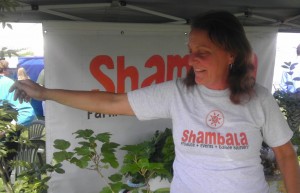When you shop at a farmers market, you see a large grouping of tents that have good, local produce ready for you to purchase. That sounds simple enough, but there is so much more to a farmers market than you may know. It takes planning, volunteer work, and monetary support to keep our local farmers returning week after week.
There are now over 50 local growers and processors that are actively participating in our local Port Susan Farmers Market. They must be in compliance with all local, county, and state regulations and must obtain the proper permits to provide samples or to sell wine. In addition, they must meet certain requirements in order to sell at a
farmers market. The Port Susan Farmers Market follows WSFMA Roots Guidelines in order to meet the consumer’s expectations of a Farmers Market:
- A Farmers Market is where a grower/processor can sell directly to the consumer and is most likely the small farmer’s best opportunity to profit from their land and efforts; and
- A Farmers Market is a marketplace where consumers can talk directly to the grower/processor, purchase the freshest produce and value-added products possible, and experience the health-giving effects of that freshness.
Volunteers have worked countless hours to make the Market what it is. A steering committee started planning the Market in 2011. That group then became the Board of Directors. They spent hundreds of hours developing our market:
- Bylaws
- Vendor Rules/Guidelines/Policies, Vendor Handbook
- Vendor Application Forms
- Blank Vendor Sales Report Form
- Business or Strategic Plan
- 501c3
Vendor recruitment and market development have been ongoing for the past three years. Board members and the Market management have talked with vendors and spoken at meetings, including the Stanwood Chamber, the Lions, the Stanwood City Council, and others, to help promote and develop this market. We have volunteers setting up, running, and closing down the Market every week. Our volunteers have helped build not only a Market with a great vendor base but a great audience of shoppers for the Market, as well.
As a farmers market, we have been working for two years with the Snohomish Health District to create a Farmers Market Program for our vendors. We’ve received assistance from Mayor Dianne White, Mayor Leonard Kelley, and Deborah Knight from the City of Stanwood. Our manager, Leslie Collins, has attended the legislative session in Olympia in 2013 with the City of Stanwood to discuss the farmers market and our longer term goals of a four-season market. All this was to lay the groundwork for future funding. Additionally, Leslie attends annual conferences, seminars, trainings, and webinars to help strengthen our market and learn how to better serve our vendors, community and program partners.
This year the market became qualified to receive SNAP/EBT benefits to increase food access for low income folks in our community. This means that the Farmers Market is truly a resource for everyone in our community. This process took months to complete and an investment of time and money to make it work. However, we’re already seeing benefits from it.
Support from the City and local business has been immense. Cash funding and in-kind donations, such as the space for the market, have made it possible to have a market at all. We received grant funding from USDA Farmers Market Promotional Program Grant and NW Farm Credit Services to help with our initial start-up costs. Since we were starting from scratch, expenses were not small. In turn, we’ve been spending money at local businesses for insurance, operating supplies, advertising, and power, to name a few. We also our refer vendors to local businesses for their needs and have helped increase foot traffic to our downtown core business during Market hours.
We spend a lot of time understanding how the market impacts the economic development of the city and surrounding businesses. This year we will be doing a more in-depth Rapid Market Assessment (RMA) to better understand these impacts. We want to constantly improve operations at the market for better vendor sales, a better customer experience and a greater benefit to all surrounding businesses.
So, you can see that our Port Susan Farmers Market is much more than a collection of tents. It’s people coming together every week to support our local businesses, invest in healthy foods, and create a great community life.





